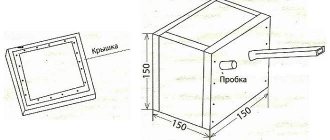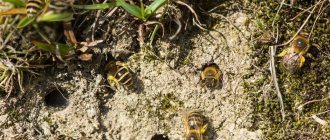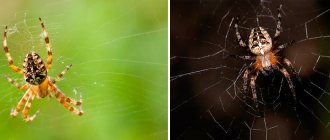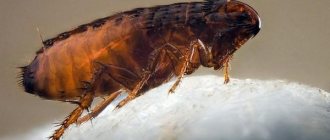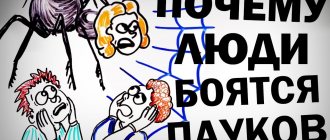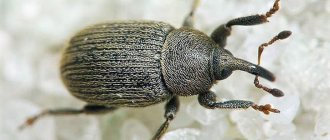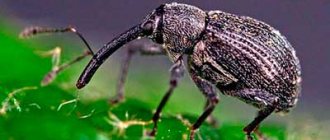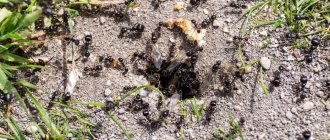For unknown reasons, it is spiders that evoke some irrationally unpleasant feelings in the vast majority of humanity - disgust, fear, disgust. With a high degree of probability, any summer resident, unexpectedly seeing such a “neighbor” on the porch, in the basement or in the room, will try, first of all, to slam him.
Let's try to use logic and figure out what types of spiders there are in our areas, where and why they get into the house, and why you shouldn't kill every spider you meet, even if its appearance doesn't make you very happy.
We will not mention poisonous exotics from the south of Russia like the South Russian tarantula or karakurt; in this material we will make do with listing the most common species of spiders that you can easily see in the middle zone, in the same Moscow region.
Funnel spiders (Agelenidae), house and labyrinth
Funnel spiders: house spider on the left, labyrinth on the right
Representatives of this family are frequent inhabitants of cellars and basements of residential buildings around the world.
The house spider (Tegenaria domestica) is usually tan in color with a "pattern" on the back, its slightly hairy body can be more than a centimeter long, and its darker legs are about twice as long as the body. Females are usually slightly larger, thicker, and shorter-legged than males.
House spiders build their rather large flat webs with a funnel-shaped indentation at one end in dark places. They themselves sit in these very “funnels”, waiting for prey, small insects - moths, flies, cockroaches. When prey gets caught in the net, they quickly rush at it and kill it. These spiders use their web for about two to three weeks, after which they leave it and weave a new one. Outdoors they can live in thick grass, wood cracks, among dry bushes, etc.
These spiders are usually active in the dark, avoid meeting people, but in the most extreme cases they can bite - the bite is practically painless and absolutely not dangerous.
Also in the low-growing dry thickets on the site live “relatives” of the house spider - labyrinth spiders (Agelena labyrinthica) , which are usually a little lighter, but look and behave exactly the same. And they are also not poisonous to humans.
Prevention of re-emergence of arthropods
The main condition for preventing the return of once expelled spiders is to maintain cleanliness in the home, leading to the complete absence of insects that serve as food for these predators.
Also, to prevent a recurrence of spider infestation, preventive measures should be taken in the form of:
- periodically spraying the room with aromatic products;
- whitewashing ceilings and walls in utility rooms with lime;
- planting in a peppermint area;
- turning on electronic deterrents with the onset of autumn cold weather.
Important! Aromatic substances repel spiders, but do not destroy them. Typically, these remedies last for a maximum of two weeks. To prolong their effectiveness, they should be renewed periodically.
Jumping spiders (Salticidae)
Different types of jumping spiders
You have probably also seen these “fluffy” medium-sized and compact spiders with large eyes and powerful legs. They easily climb vertical surfaces, including “inconvenient” ones like glass. They can often be seen near human habitation on stone and brick walls, where they bask in the sun. These spiders are also found in thick grass. The color of these arachnids can be very different - black, light brown, striped, spotted.
Jumping spiders are active daytime hunters; they do not weave webs, but track prey (insects and the smallest vertebrates) and jump at it, often over long distances.
Jumping spiders that live in our latitudes are absolutely safe and not poisonous to humans.
Vacuum cleaner
It is important to keep your home clean to prevent pest infestations, including spiders. Areas that attract spiders should be cleaned, such as stacked storage boxes, piles of newspapers and old magazines, and things under the bed and sink.
When vacuuming, make sure to remove all cobwebs, along with spiders and their eggs.
Vacuum behind and under the bed, as well as closets, sofas, chairs, nightstands and other furniture every week. Use attachments to clean air ducts, ceilings, light fixtures and corners. Keep your bookshelves clean and organized.
Cover vents and kitchen chimneys with fine mesh insect screens.
7:1240 7:1250
Hay-making spiders, or long-legged spiders (Pholcidae)
Harvesting spider
Among these small spiders there are many synanthropic species - that is, they are the ones you can easily find in a person’s home.
They have a pale, naked body several mm long with a constriction stalk at the point of transition from the abdomen to the cephalothorax, and the length of the legs can exceed the body size by 20 times, for which the harvestmen are given the name “long-legged”.
Haymaking spiders are predators; they feed on all sorts of creeping and flying little things, which they catch in their randomly woven webs, where they can hang motionless upside down for hours. You can notice these cobwebs in dark, dry and warm corners of rooms (usually abandoned or rarely visited). Spiders can also settle in the open air - in hollows of trees, under stones and dead wood, etc.
Of course, these little ones are not at all dangerous for humans and, when they meet them, they will first of all try to run away and hide.
Haymaker
In the Arachnida class, in addition to the Spiders order, to which the above-described centipedes belong, there is another separate order, Haymakers. Many people know these arthropods under their childhood nickname “braidtail”. They have the same long legs, but the abdomen is segmented and connected to the cephalothorax by a wide base, and not by a “stalk” like a spider. Mosstails feed on small insects, as well as plant tissues, and are absolutely safe for humans! And the mechanism of independent contraction of severed limbs helps the harvester to distract predators in order to have time to run away and hide.
Ways of deliverance
There are several ways to get rid of spiders, each of which has its supporters and opponents:
- traditional methods are based on the use of simple improvised means - usually aromatic substances, the smell of which is unpleasant to arachnids;
- chemicals are a radical means of killing spiders;
- modern electronic devices for repelling and expelling from the territory;
- cleaning with the destruction of nests and removal of adults and eggs.
Note that all these methods are good for indoors. Finding a reliable solution for spiders on the street is difficult. All methods are effective only for a short time. In the future, the territory will again be populated by new aliens, and the fight will have to continue.
General cleaning of the house
Thorough cleaning of the house with an inspection of all corners, nooks, secluded warm places behind radiators and under the bathroom will destroy the comfort and coziness of the existence of spiders in the home. How to properly clean:
- The first stage is the destruction of food. Not forgetting that spiders feed on insects, you need to start removing cockroaches, flies, and bedbugs.
- Inspect and clean indoor plants and remove insects from them.
- Thoroughly rinse all corners and backs of furniture. Shake and treat carpets and upholstery. Wash the curtains.
- Light arthropods and masonry can be easily removed with a vacuum cleaner, which should be used regularly.
- Wash and ventilate the bathroom, toilet and kitchen well; arachnids often live near water.
- Dismantle the rubble of old rubbish in closets, loggias, utility rooms, basements and attics.
- Seal the cracks in the windows and install fine-mesh mesh on the vents.
In private homes, all buildings, sheds, and garages must be removed. When fighting spiders, you need to burn the rubble of unused junk that litters the site and outbuildings.
Outdoor cleaning
- On the street, in the garden and vegetable garden, it is useful to remove trash from fences and weed out weeds. Cultivated plants are constantly hilled up, pruned, watered - spiders make nests in quieter places where weeds grow.
- In greenhouses, cottages and local areas, it is necessary to combat insect pests, preventing population growth.
- Trees and fences are whitewashed with lime, which serves as an arachnid repellent.
- Peppermint is a good way to protect your area from spiders. It is seated near the house and throughout the territory in small groups. The specific smell scares away and forces animals to look for other places for breeding.
Wanting to get rid of spiders, cleanliness is constantly maintained. It is useful to ventilate apartments and houses, while providing windows and doors with protective nets. A radical remedy for all household pests is repair, which reliably and permanently eliminates the presence of unwanted guests.
Ultrasonic repellers
The idea that spiders are harmless is firmly rooted in the minds of many people, so most people do not want to use poison. Many owners prefer to get rid of their guests using humane methods.
Electronic devices that emit sound and electromagnetic pulses simply expel the aliens from the house can help with this. This spider and insect repellent is harmless to people and pets.
Review of popular repellers:
- Pest Reject. The device emits electromagnetic pulses and ultrasonic waves. Cost – from 400 rubles.
- Tornado TM-9034. The device is more expensive (from 1,700 rubles). Eliminates spiders with varying frequency waves, to which pests are not accustomed. Creates electrical impulses and generates negative ions.
- EcoSniper. A whole series of electronic devices with different coverage areas, sources of exposure to animals and insects.
- Beetle L3. It has a small coverage area (30 square meters), but runs on batteries, which allows it to be used anywhere.
- WK-3523. The set consists of 3 pieces for use in separate rooms. These ultrasonic repellers work from the mains.
Note that many consider mosquito and other insect exterminators to be the best remedies for spiders in a private home and on the street. These electronic devices (MV-026B, E-Etkap Go, Dachny-2, others) repel and destroy arthropods, which are food for spiders. Animals do not breed in areas where there is not enough food, and devices are constantly running.
Chemicals
Pesticides deal a double blow - they eliminate insects and spiders. In most cases, one product is enough to completely destroy all pests. It is important to choose the right drug that has a wide spectrum of activity.
Raid
The line of products is available in the form of sprays, which makes it much easier to use against arachnids. It has the greatest effect with direct contact, so to get rid of pests you need to spray in all corners, on cobwebs, behind cabinets.
Valid for up to 4 weeks.
Raptor
The Raptor series of drugs destroys different types of insects living in homes. The following forms of insecticides are available:
- aerosol;
- gel;
- aquafumigator;
- trap.
Aerosol agents are considered the most effective and convenient against spiders. They are easy to spray near cobwebs, in corners where animals gather. The spray does not leave marks on the walls.
Bros
A multi-component product that quickly eliminates spiders and their food. The spray is sprayed onto areas where cobwebs accumulate, in the corners. When processing, it is important to follow the standards given in the instructions in order to completely remove parasites.
Bros is used in dachas, verandas, and streets. The residual effect lasts up to 3 months, although it shows the greatest activity within 3-4 hours, with direct contact.
Clean house
The dust has the form of a powder, which is scattered along the baseboards. It is convenient to use if there are crawling insects in your home that can be poisoned along with spiders.
The drug creates long-term protection, completely eliminating various pests.
Mashenka
A budget-friendly solution is crayons. White lines are not noticeable on the walls; you can draw them near the web and on the floor. The insecticide is effective for up to a month; washed out lines are painted on again if necessary.
Joker Bun
The Turkish-made spray has no odor, which is a plus when used in apartments. It is also effective when treating local areas. Quickly kills spiders and insects when sprayed, lasts up to a month in enclosed spaces.
Any chemical repellents for spiders in the house and apartment should be used in strict accordance with the instructions. The drugs have a hazard class of 3. When spraying, you can inhale fumes, so use protective masks. Recommended spray rates should not be exceeded.
For non-residential premises, stronger preparations can be used; some use the usual Dichlorvos.
Even with strong means it is impossible to completely remove arachnids from areas. Some dacha owners call special services that use professional preparations and methods. By reducing the population of insects (in particular, mosquitoes) in the country, they achieve a reduction in the number of spiders.
Folk remedies
Most traditional methods use aromatic substances, the smell of which is unpleasant to arachnids. You need to be prepared that when using them, the apartment will smell of vinegar or essential oils. Before choosing products, you need to make sure that your household is not allergic to these substances.
Vinegar
Table vinegar is a cheap, simple remedy against arachnids in the apartment. It is diluted with water in a ratio of 1/1 and sprayed with a spray bottle in places where there are cobwebs, corners, and behind heating radiators. It is important to go through the entire house, not forgetting the bathroom and toilet.
When wet cleaning, vinegar is added to the water for washing walls and floors.
Lemon
Your favorite citrus is used in different ways:
- cut and placed on saucers in rooms;
- infuse chopped lemon in water and add the solution to the water for washing;
- use essential oil (10-20 drops per liter) to irrigate the walls.
The constant smell of lemon in the apartment is unpleasant for spiders, they leave the premises.
Essential oil
Arachnids cannot tolerate many odors and leave the house. To spray the walls, use orange, lemon, tangerine, and eucalyptus oil. 10-20 drops of oil are added to water for spraying or washing the apartment. It is important to close windows and doors during such cleaning, creating the maximum concentration of aromatic substances.
horse chestnut
Horse chestnut fruits are crushed and laid out indoors. A specific smell drives arachnids out of houses. Chestnut bookmarks need to be regularly updated with fresh ones to enhance the effect.
Diatomite
Diatomaceous earth flour is scattered along the baseboards - if adults get on it while moving, they die. In an apartment, this spider repellent is considered the most reliable.
Boric acid gives a good effect. Prepare a solution - a sachet of product per liter of water. Wash or spray the walls and floors of the house with a solution.
Sticky insect traps are used to catch arachnids. To avoid unsanitary conditions, they should be changed more often.
Yellow pouch spider or chirocontid (Cheiracanthium punctorium)
Yellow sac spider
These spiders are quite rare and prefer to live in very dry, hot climates, which is why they are more often found in Asia. However, recently, apparently due to climate change, cases of their detection have become more frequent not only in Eastern, but even in Central and Western Europe, so knowing the “enemy in person” will be useful.
Why enemy? Because meeting him, of course, will not be fatal, but it will cause you trouble. Its bite is not only deep and painful, but can also cause unpleasant symptoms such as nausea, swelling, chills, fever and increased blood pressure. Usually painful symptoms disappear within 24-30 hours, otherwise hospitalization is necessary.
The size of this spider is average, about 1-1.5 cm, it has a yellow-brown or greenish dense body, somewhat pointed towards the rear end, strong legs and powerful chelicerae (oral “biting” appendages).
This spider lives in grassy and bushy thickets and can hide in leaves rolled into tubes. It does not weave a wide web, but attacks victims (insects, ticks, small caterpillars) in a jump. Females that lay eggs in tall grass may aggressively defend their cocoons.
Reasons for appearance
Being predators, these arthropods need live food, which is provided by other insects. Thus, the main prerequisite for the presence of spiders in human housing is its population with flies, cockroaches, ants, bedbugs and others.
In addition, arthropod predators may choose this or that housing due to:
- warmth, which attracts arthropods with the onset of autumn cold weather;
- humidity, which is constantly present in bathrooms and kitchens, being the most suitable condition for spiders;
- untidy home, which provokes the proliferation of insects, which are food for arthropod predators.
Orb-weaving spiders (Araneidae), crossworts and argiopes
Cross spiders
Orb weavers usually live on tall shrubs and trees in forest ecosystems, although they can also be found in populated areas.
These spiders are very diverse in size, body shape and color, so it is quite difficult to create a general description.
Of this family, people are most familiar with crosses - they got their name due to the pattern of their thick abdomen, where, against a darker background, light spots form a figure similar to a cross. The body size of these brown, gray, black arthropods is usually 1-2 cm, and the body covering is waxy.
At the end of summer and autumn, large nets-“wheels” of crosses are visible everywhere - in the forest, in gardens, on hedges, under the roofs of buildings, in the darkened corners of buildings, in the window frames of abandoned houses. The fact is that juveniles begin to build nets in the spring, increasing them month after month. These spiders feed on flying insects and are safe for humans - their possible bite, by medical standards, is no more dangerous than a mosquito bite.
Argiope spiders
Orb weavers also include argiopes - very common spiders in our country, which also weave dense wheel-shaped webs on shrubs and herbaceous plants in sunny, often dry places and sit in their center, waiting for prey. In autumn, argiopes actively disperse through the air with the help of cobwebs.
These are medium-sized spiders, about 1.5 cm in length, and females and males can look different - with a thick black and yellow striped abdomen, with a silver-white notched abdomen, with a narrow beige abdomen... These spiders have long legs , can be plain or striped, often located in pairs at the anterior and posterior ends of the abdomen, so that the spider looks like the letter X.
Argiopes feed on various insects, including large ones; their poison is not dangerous for humans and animals, although the bite can be painful.
Some of the orb weavers are included in the regional Red Data Books of Russia and are protected!
Empty jar
5:50 6:559 6:569
You can save the life of the spider and at the same time get rid of it in another elementary way. As soon as you have discovered the spider's lair, take an ordinary glass jar and a piece of paper - even a sheet from a notebook, then carefully cover the spider with the jar, place a piece of paper under the neck, turn the jar over and go into nature, where you will perform an act of mercy by releasing the insect onto the grass... True, there may be a bird nearby...)
6:1356 6:1366 7:1871
7:9
Knitting spiders, or tetragnathids (Tetragnathidae)
Knitting spider
These spiders prefer to settle on vegetation in damp meadows and forest edges, often on grass and bush branches along water bodies.
Knitters have an elongated, brown or gray, often shiny body 6-12 mm in length, and long legs are often extended back and forth in pairs, mimicking and visually turning into a “stick”.
Tetragnathids build round trapping nets (both horizontal and vertical), often with a hole in the center or very large rectangular cells, feed on insects (mainly mosquitoes and flies), and do not pose any danger to humans.
Silver spider or water spider (Argyroneta aquatica)
Silver spider
This is the only European aquatic species of spider, so you will not confuse it with anyone else.
Their body is round, gray or brown, up to 15 mm in length, covered with many velvety hairs. They also differ from other spiders in having long swimming bristles on the hind legs and three claws on the legs of the three hind pairs.
Silverfish are often found in still or slow-moving waters. It feeds on various small animals that become entangled in the threads of its underwater web or which it catches while swimming in the water.
A water spider bites very rarely and only for the purpose of self-defense. A person can be injured accidentally by being pulled out of the water along with fish or aquatic plants. Redness, pain, burning, swelling, and swelling appear at the site of the bite. People prone to allergies, with weak immune systems, and young children may experience a deterioration in their health after a spider bite - weakness, nausea, dizziness, headache, and fever. The condition returns to normal in a few days. To speed up the therapeutic effect, take antihistamines.
In some places, silverfish are included in the regional Red Books of Russia and are protected!
How to get rid of spiders in an apartment or private house, how to treat the house against spiders?
There are a lot of folk recipes and chemicals to get rid of these insects. The choice of one or another means of struggle depends on the conditions in which you live. You should not use chemicals and powders if there is a child or pet in the house.
Types of means to get rid of spiders:
- Chemical. These are a variety of poisons and poisons. They may be sold in powder or liquid form. They are applied to the usual habitats of insects.
- Folk recipes. To get rid of spiders, substances that smell strongly are often used. This is vinegar, essential oils.
- Ultrasonic repellers. The operation of the device is based on sound, which is not heard by humans, but is perfectly felt by insects. They simply leave their home.
How to get rid of spiders in an apartment or private house, how to treat the house against spiders?
Crab spiders, or sidewalkers (Thomisidae)
Crab spiders
These representatives of arthropods are distinguished by a very swollen spherical abdomen against the backdrop of thin legs.
The color of their body (up to 10 mm long) can be nondescript white, greenish, beige, or, conversely, very bright - two-color, patterned, striped. The first two pairs of legs of these spiders are usually much longer than the hind ones.
Crab spiders can move sideways, which is why they got their nickname. They do not build trapping nets, but lie in wait for their prey (insects and small spiders), sitting on flowers, on leaves, in litter or on the bark of trees. They are absolutely not dangerous for humans.
